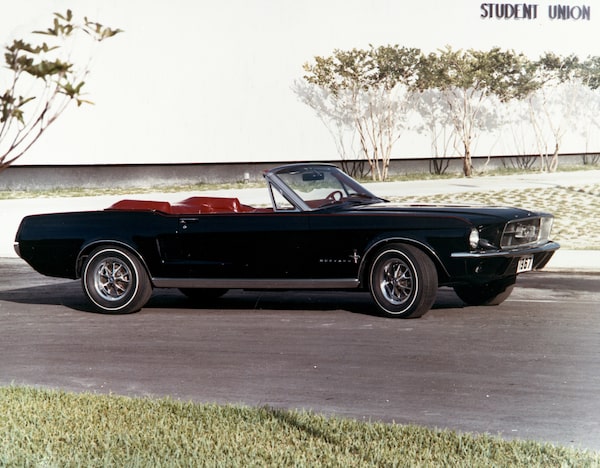
The 2019 Ford Mustang soft-top convertible.Courtesy of manufacturer
Since everyone’s grand plans have been abruptly cancelled this year, many people are turning to life’s simpler pleasures: baking bread, online shopping, trying (but mostly failing) to grow tomatoes, sewing face masks and doing endless video chats.
To that list of summer 2020 activities, we’d suggest adding the pure joy of top-down driving. If you’ve been staying home and feeling cooped up, hitting the open road with the wind in your hair and the sun on your face will feel even sweeter than usual.
Top-down cars come in many forms – spiders, targa tops, barchettas, drophead coupés – and each variety has its pros and cons.
First, you’ve got the generic catch-all term, convertible, and its slightly more posh counterpart, cabriolet. If you’re very fancy, as Rolls-Royce is, a convertible can also be called a drophead coupé. The differences are in name only.
In most cases, the floppy handling that convertibles and cabriolets were once derided for has been eliminated, thanks to stiffer body structures. Modern convertibles now handle less like a wet noodle and more like their fixed-roof counterparts. You’re only likely to notice any differences on a truly terrible road or flat-out on a racetrack.

In decades past, convertibles like this 1967 Ford Mustang were known to have floppier handling than their fixed-roof counterparts.Courtesy of manufacturer
The stiffer body structures of modern convertibles have also made them much safer than the convertibles of old.
In the 1960s, the U.S. government looked into banning convertibles altogether on safety grounds, which pushed car companies to develop alternatives such as the T-top and targa top. They were designed to be safer in the event of a rollover, both featuring a fixed pillar behind the driver and passenger. Only the part of the roof directly above the occupants is movable.

Courtesy of manufacturer

The 2021 Porsche 911 Targa.Courtesy of manufacturer
Today, Porsche is one of the few companies still making targa-top convertibles, as evidenced by the new 2021 911 Targa. What’s more, they’re still popular, especially in countries with less-than-perfect climates. Canada is the second-largest market worldwide for the 911 Targa, behind Germany and ahead of the U.K. The new Corvette and Mazda MX-5 RF also have targa-tops.
Porsche plucked the Targa name from Sicily’s legendary Targa Florio road race. The 1960s Triumph TR4 had a similar-looking roof and, had that car been as big a hit as the 911, the targa top would now have been known by Triumph’s label: the Surrey top.
The advantage is mostly one of packaging; targa tops are more compact than traditional convertible tops, which is why you’ll often find them on compact and mid-engine sports cars.

The 2020 Chevrolet Corvette has a convertible variant.Courtesy of manufacturer
T-tops, however, have been relegated to the history books. They featured separate movable roof panels above each front seat, but they were prone to leaking and probably reached their spiritual zenith with the 1970s Pontiac Firebird or maybe with the 1980s Subaru BRAT.
In the wide world of convertibles, you will also come across roadsters and spiders (sometimes written as spyders). These labels originated in the earliest days of the automobile. Today, they’re liberally applied to any two-seat sports car with a folding roof. The different monikers have more to do with marketing than anything else.
Next, you’ve got oddities such as the Fiat 500C. A name has yet to be invented for its folding cloth roof that slides down between two rails. Curtain top, perhaps? The Jeep Gladiator pickup looks strange too, something like a transformer. It’s available with hard-top and soft-top options, both of which are completely removable, along with the doors.

The Nissan Murano CrossCabriolet was a soft-top convertible SUV.Mike Ditz/Courtesy of manufacturer
Traditional convertible tops come in two main varieties. Soft tops are made of cloth, as you’ll find on the Ford Mustang, Mazda MX-5, and the gone-but-not-forgotten Nissan Murano CrossCabriolet. Metal hard tops are found on cars such as the Mercedes-Benz SLC, BMW M4 and McLaren 600 LT. Hard tops can make for a quieter cabin, but are also heavier and less compact when folded. Hard and soft tops usually hide away under a cover behind the seats, often eating into trunk space.
On the most extreme end of the convertible spectrum, you have speedsters and barchettas, which is Italian for “little boat.” These cars don’t have a roof at all – or maybe just a minimal cloth top for emergencies – and a short or non-existent windshield. The new McLaren Elva is a fine example of the genre, as are the Ferrari Monza SP1 and SP2 and the Aston Martin V-12 Speedster. To drive these, you’ll want to wear a helmet and probably some ear plugs.

Courtesy of manufacturer

The Aston Martin Speedster, top, and McLaren Elva are a couple recent barchetta models.Courtesy of manufacturer
No matter what sort of roofless wonder you choose for the summer of 2020, one thing all convertibles have in common is a lack of luggage space. So, pack lightly. If you ask us, that’s a small price to pay for the feeling of sun on your face and wind in your hair, and the simple pleasure of open-air motoring.
Shopping for a new car? Check out the Globe Drive Build and Price Tool to see the latest discounts, rebates and rates on new cars, trucks and SUVs. Click here to get your price.
Stay on top of all our Drive stories. We have a Drive newsletter covering car reviews, innovative new cars and the ups and downs of everyday driving. Sign up for the weekly Drive newsletter, delivered to your inbox for free. Follow us on Instagram, @globedrive.